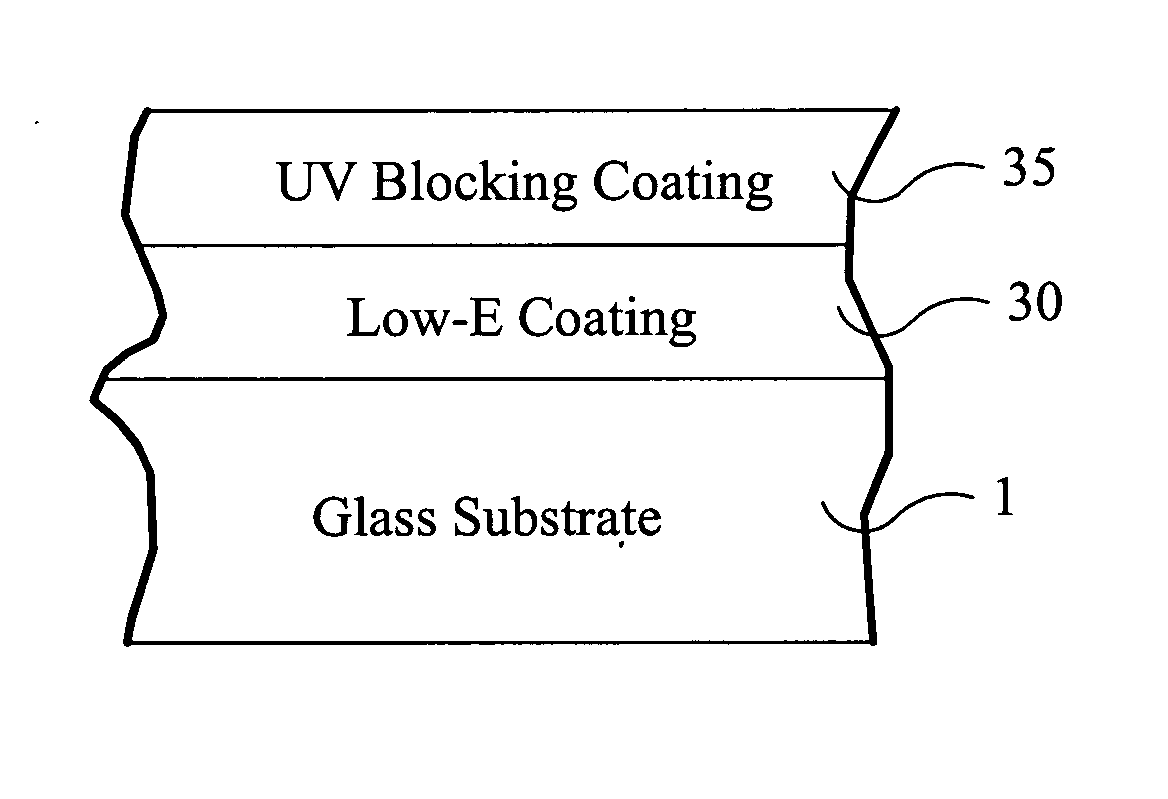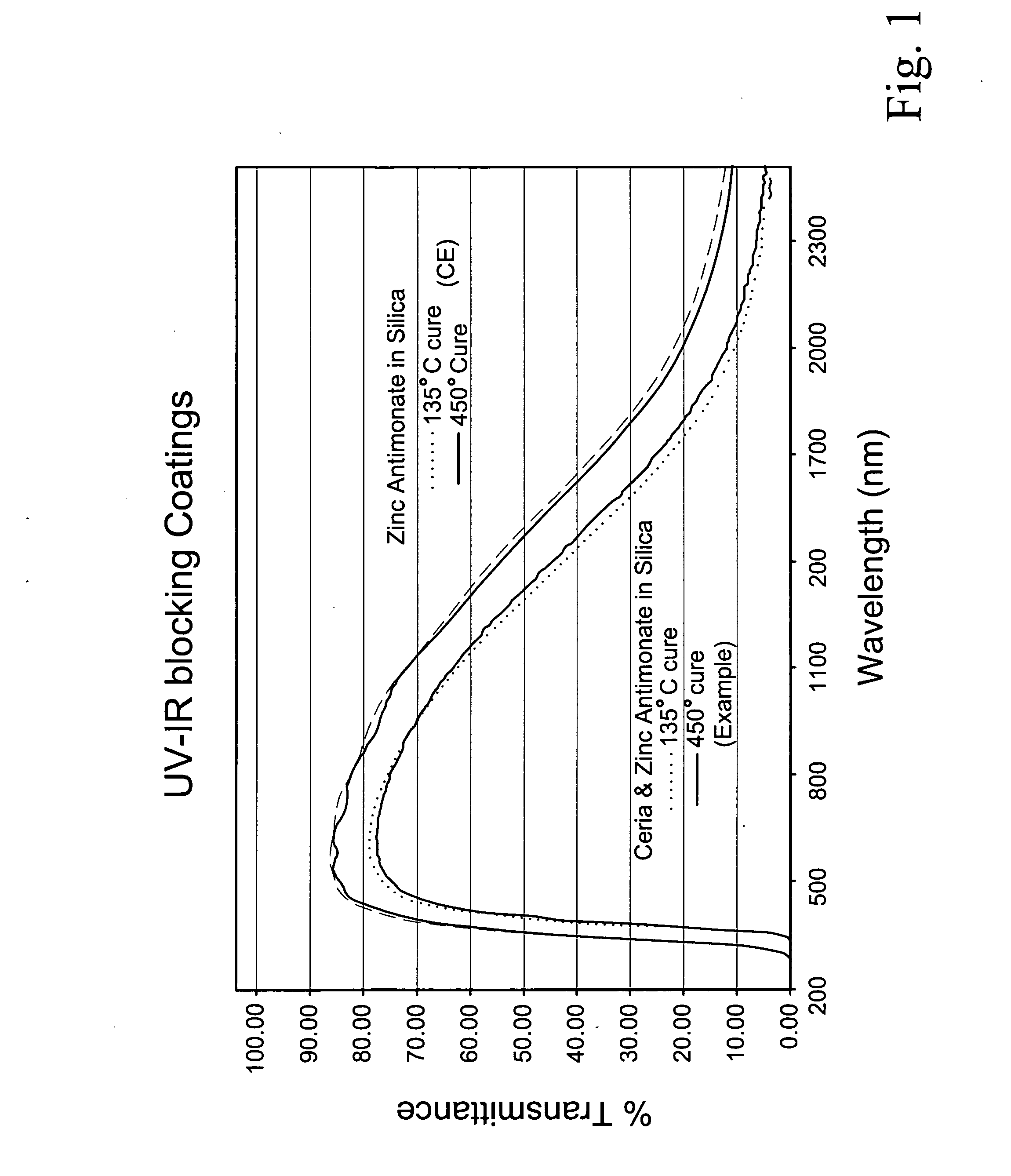Coated glass substrate with infrared and ultraviolet blocking characteristics
a technology of infrared and ultraviolet blocking, applied in the direction of coating, natural mineral layered products, coatings, etc., can solve the problems of inability to block significant amounts of ultraviolet radiation, poor coating effect, and inability to achieve single-layer coating of ser. no. 11/229,837, etc., to achieve cost-effective effect and minimal steps
- Summary
- Abstract
- Description
- Claims
- Application Information
AI Technical Summary
Benefits of technology
Problems solved by technology
Method used
Image
Examples
example 1
[0048] In Example 1, a coating solution (for a UV blocking coating that blocks significant amounts of UV radiation) was prepared by combining about 3.4 gm of pre-hydrolyzed titanium tetrabutoxide sol of about 5% by weight of titania in n-propanol, and about 2 gm of cerium (III) nitrate solution of about 18.2% by weight ceria in n-propanol. The mixture was stabilized by using diethyleneglycol dibutylether. This mixture will be referred to in this example as the coating solution. The resulting coating solution was spin coated onto a temperable glass substrate 1 having the low-E coating 30 thereon as shown in FIG. 8. Details of the low-E coating 30 may be found in Ser. No. 10 / 914,636. The coated glass was then dried on a hot plate set at about 130 degrees C. for about five minutes and then heated in an oven at about 220 degrees C. for about five minutes for curing the coating solution, before it was subjected to about 650 degrees C. for about four minutes. Thus, the result was a therma...
example 2
[0050] In Example 2, the same coating solution (for a UV blocking coating that blocks significant amounts of UV radiation) of Example 1 was spin-coated directly onto a glass substrate under identical conditions as that described above in Example 1. In other words, in Example 2 the resulting coated article had no low-E coating 30. The same heat processing conditions of Example 1 were also used in Example 2. Thus, the result was a thermally tempered coated article including the UV coating 35 provided directly on the glass substrate 1. The UV blocking coating 35 was thus made up of a mixture of oxides of cerium and titanium (e.g., CeO2 / TiO2). Spectral characteristics of this coated article of Example 2 are shown in FIGS. 2-3 by the dotted line with long dashes. It can be seen, especially in FIG. 2, that the coated article of Example 2 has similar UV blocking characteristics to Example 1, but not nearly as good of IR blocking characteristics as Example 1 due to the lack of the low-E coa...
example 3
[0051] In Example 3, the same coating solution (for a UV blocking coating 35 that blocks significant amounts of UV radiation) of Example 1 was spin-coated onto a glass substrate 1 over a low-E coating 30 under identical conditions as that described above in Example 1, except that a different low-E coating was provided on the glass. In this Example, the low-E coated glass was TEC-15 commercially available from Marsco Industries, located in Illinois. The coated glass substrate was subjected to the same temperature treatments as in Example 1. The UV blocking coating 35 was thus made up of a mixture of oxides of cerium and titanium (e.g., CeO2 / TiO2). The UV blocking coating 35 was again about 0.14 μm thick. Spectral characteristics of this coated article are shown by the solid thick line in each of the graphs of FIGS. 4-5. FIG. 4 illustrates the spectral characteristics of this monolithic coated article over a wide range of wavelengths, whereas FIG. 5 focuses on the spectral characteris...
PUM
| Property | Measurement | Unit |
|---|---|---|
| thickness | aaaaa | aaaaa |
| thickness | aaaaa | aaaaa |
| wavelength range | aaaaa | aaaaa |
Abstract
Description
Claims
Application Information
 Login to View More
Login to View More - R&D
- Intellectual Property
- Life Sciences
- Materials
- Tech Scout
- Unparalleled Data Quality
- Higher Quality Content
- 60% Fewer Hallucinations
Browse by: Latest US Patents, China's latest patents, Technical Efficacy Thesaurus, Application Domain, Technology Topic, Popular Technical Reports.
© 2025 PatSnap. All rights reserved.Legal|Privacy policy|Modern Slavery Act Transparency Statement|Sitemap|About US| Contact US: help@patsnap.com



